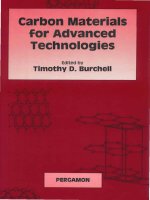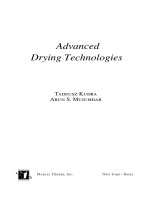advanced drying technologies
Bạn đang xem bản rút gọn của tài liệu. Xem và tải ngay bản đầy đủ của tài liệu tại đây (3.22 MB, 467 trang )
Marcel Dekker, Inc. New York
•
Basel
TMA
Advanced
Drying Technologies
Tadeusz Kudra
Arun S. Mujumdar
ISBN: 0-8247-9618-7
This book is printed on acid-free paper.
Headquarters
Marcel Dekker, Inc.
270 Madison Avenue, New York, NY 10016
tel: 212-696-9000; fax: 212-685-4540
Eastern Hemisphere Distribution
Marcel Dekker AG
Hutgasse 4, Postfach 812, CH-4001 Basel, Switzerland
tel: 41-61-261-8482; fax: 41-61-261-8896
World Wide Web
The publisher offers discounts on this book when ordered in bulk quantities. For more
information, write to Special Sales/Professional Marketing at the headquarters address
above.
Copyright 2002 by Marcel Dekker, Inc. All Rights Reserved.
Neither this book nor any part may be reproduced or transmitted in any form or by
any means, electronic or mechanical, including photocopying, microfilming, and re-
cording, or by any information storage and retrieval system, without permission in
writing from the publisher.
Current printing (last digit):
10987654321
PRINTED IN THE UNITED STATES OF AMERICA
Preface
Drying is a ubiquitous operation found in almost all industrial sectors, ranging
from agriculture to pharmaceuticals. It is arguably the oldest, most common,
most diverse, and most energy-intensive unit operation—and, coincidentally,
is also one of the least understood at the microscopic level. Drying technology
is an amalgamation of transport phenomena and material science since it deals
not only with the removal of a liquid to produce a solid product but also with
the extent to which the dried product meets the necessary quality criteria.
Until a little over two decades ago, developments in drying occurred at
a remarkably slow pace. Indeed, one wondered if the field showed any visible
signs of progress. Spurred by the energy crisis, consumer demand for better
quality, and the initiation of the biennial International Drying Symposium se-
ries, advances on both the fundamental and applied fronts began by leaps
and bounds. Literally thousands of technical papers of archival interest were
published and made widely available. This had a synergistic effect of promot-
ing further advances in the truly inter- and multidisciplinary field of drying
technology.
This book is a direct outcome of the phenomenal growth in drying litera-
ture as well as new drying hardware. It is now virtually impossible for aca-
demic and industry personnel to keep abreast of the developments and evaluate
iii
iv Preface
them logically. Therefore, the main objective of this book is to provide an
evaluative overview of the new and emerging technologies in drying that are
not readily accessible through conventional literature. We have attempted to
provide a glimpse of the developments that have taken place in the past two
decades and the direction toward which we see these technologies heading.
We have included some well-established new technologies that are already
commercialized, such as the superheated steam drying of pulp in flash or pres-
surized fluidized bed dryers, and laboratory curiosities, such as the displace-
ment drying of wood (displacing water with the more volatile alcohol). Our
hope is that some of the laboratory curiosities of today will lead to truly revolu-
tionary drying technologies in the future; a systematic classification and evalu-
ation of current technologies will hopefully lead to new ideas.
Innovation and knowledge are often called the flip sides of the same
coin. It is important to know what drives innovative ideas to the marketplace.
Here we also tried to look at the process of innovation and compare the innova-
tive technologies with the more conventional ones, noting that novelty per se
is not the goal of innovation.
As can be seen readily from a cursory look at the book’s contents, we
include dryers for all types of materials—from slurries and suspensions to
continuous sheets such as paper and textiles. We cover low-tech, low-value
products such as waste sludge to high-tech advanced materials, biotechnology
products, and ceramics. We include production rates that range from fractions
of a kilogram per hour (some pharmaceuticals) to tens of tons per hour (paper,
milk, etc.). Further, we deal with drying processes that are completed in a
fraction of a second (e.g., tissue paper) to several months (certain species of
wood in large-dimension pieces). Thus, the scope is broad and, as the reader
will find out, the range of innovations is truly breathtaking.
Finally, no new technology will see the light of day without appropri-
ately supported R&D. We have therefore tried to identify holes in our current
knowledge regarding drying and dryers that will provide new challenges to
the new generation of academic and industrial researchers, eventually leading
to better drying technologies.
Tadeusz Kudra
Arun S. Mujumdar
Contents
Preface iii
Part I. General Discussion: Conventional and Novel Drying
Concepts 1
1. The Need for Advanced Drying Technologies 3
2. Classification and Selection Criteria: Conventional Versus
Novel Technologies 11
3. Innovation and Trends in Drying Technologies 19
Part II. Selected Advanced Drying Technologies 27
4. Drying on Inert Particles 29
5. Impinging Stream Drying 49
6. Drying in Pulsed Fluid Beds 69
v
vi Contents
7. Superheated Steam Drying 81
8. Airless Drying 113
9. Drying in Mobilized Bed 119
10. Drying with Shock Waves 131
11. Vacu Jet Drying System 149
12. Contact–Sorption Drying 157
13. Sonic Drying 187
14. Pulse Combustion Drying 211
15. Heat-Pump Drying 239
Part III. Selected Techniques for Drying and Dewatering 265
16. The Carver–Greenfield Process 267
17. Drying in a Plasma Torch 271
18. Displacement Drying 281
19. Vapor Drying 291
20. Slush Drying 297
21. Atmospheric Freeze-Drying 303
Part IV. Hybrid Drying Technologies 311
22. Radio-Frequency Drying with 50-Ohm Technology 313
23. Radio-Frequency-Assisted Heat-Pump Drying 323
24. Radio-Frequency–Vacuum Drying 329
25. Microwave–Convective Drying 335
Contents vii
26. Microwave-Vacuum Drying 347
27. Filtermat Drying 355
28. Spray–Fluid Bed–Vibrated Fluid Bed Drying 359
29. Combined Filtration and Drying 363
30. Other Hybrid Technologies 381
Part V. Other Techniques 385
31. Special Drying Technologies 387
Symbols 417
References 429
Index 455
Part I
General Discussion: Conventional
and Novel Drying Concepts
This part provides a general discussion of the need for new (advanced) drying
technologies, objectives of drying R&D, classification and selection criteria
for conventional and advanced drying technologies, as well as some thoughts
on innovation and R&D needs. All of these topics are covered briefly; thus,
the interested reader will need to refer to the literature cited for details. The
objectives of this part of the book are to provide a concise introduction to our
philosophy and to assist in using the information provided here.
1
1
The Need for Advanced
Drying Technologies
1.1 WHY NEW DRYING TECHNOLOGIES?
Authors of a book such as this must honestly answer this fair question. It is
true that we already have scores of conventional dryers with well-established
records of performance for drying most materials. However, not all of these
drying technologies are necessarily optimal in terms of energy consumption,
quality of dried product, safety in operation, ability to control the dryer in the
event of process upsets, ability to perform optimally even with large changes
in throughput, ease of control, and minimal environmental impact due to emis-
sions or combustion of fossil fuels used to provide energy for drying. Most
drying technologies were developed empirically over sustained periods of
time, often by small vendors of drying equipment with little access to R&D
resources—human or financial. They were also designed at a time when en-
ergy and environmental considerations as well as quality demands were not
very stringent. Indeed, many have been upgraded satisfactorily to meet legisla-
tive and competitive restrictions. Perhaps most are already designed and oper-
ated at their asymptotic limit of performance. However, if for any reason we
wish to exceed their current performance in a cost-effective way, we need to
3
4 Chapter 1
look for alternative technologies with a higher asymptotic limit to perfor-
mance—which is necessarily below the maximum defined by thermodynamic
constraints.
The majority of novel drying technologies, which evolved through a
process of evolutionary incremental improvements, was built in to offset some
or all of the limitations faced in operating conventional dryers. The benefits
are typically also incremental rather than dramatic. Some of the new technolo-
gies may even start at a performance level below that of a conventional dryer.
From this point of view it is not a fair comparison: novel versus conventional
might be like comparing apples and oranges. We urge our readers not to be
judgmental at this stage and rule on novel dryers simply because they do not
have a significantly superior performance at this time, since not much effort
has yet been devoted to a greater study of such technologies. Rather, they
should study their potential and compare the predicted asymptotic limits of
performance. Even on this scale some of these technologies may not turn out
to be commercially successful in the long run and may disappear. However,
we must give new ideas a chance—some of them definitely will emerge as
victors and those choosing them will be the beneficiaries. Note that dryers
have a lifetime of 30 to 40 years; a lifetime cost is the only way to really
make a proper choice between conventional and new dryers. Novelty should
not be the chief criterion in the selection of a dryer—it should be the last, if
at all.
A conventional dryer may be admirably suited for a specific applica-
tion while another may need one to look outside the conventional set of
dryers. One must set the criteria for selection and then see which one meets
them better and more cost effectively. There is a cost associated with the
risk accompanying the technology not verified in pilot scale. Most companies
shun this and are prepared to pay a higher cost for a conventional technol-
ogy—the premium is often considered an insurance premium rather than a
cost.
In some cases new drying technologies are sought simply because the
current technologies have a limit in terms of the production rates possible.
For example, today’s modern newsprint machine is limited by the dryer speed.
One can make the wet paper sheet faster than it can be dried cost effectively
on the current multicylinder dryers. For higher speeds entirely new drying
concepts are being evaluated.
In the following sections we will review two evolutionary types of ad-
vances in drying technologies, specifically the intensification of drying rates
and multistaging of convective dryers.
The Need for Advanced Drying Technologies 5
1.2 INTENSIFICATION OF DRYING RATES
It is obvious that reduction of the size of the dryer will lead to a reduction in
initial capital cost. Although this should not be a deciding factor in the selec-
tion of an individual dryer, since only 10 to 15 percent of the life-cycle cost
of a direct dryer is due to the initial capital cost of the drying system, it is
still an important consideration as it can reduce the space requirement, duct
sizes, size of ancillary equipment, etc., as well. One must intensify the drying
rates without adversely affecting product quality in order to make the equip-
ment smaller.
Reduction of capital and operating costs of dryers clearly depends on
the feasibility to enhance drying rates within the limits of product quality
requirements. Higher drying rates translate into a smaller physical size of the
dryer as well as the associated ancillary equipment. Generally, it is also re-
flected in lower running costs. An example is drying of liquid feeds in a fluid-
ized or spouted bed of inert particles (see Chapter 4) where highly intensified
heat and mass transfer results in high volumetric evaporation rates so the dryer
volume can be reduced significantly as compared to the conventional spray
dryer of the same throughput.
In general, the feedstock may contain both surface and internal moisture.
The rate at which the surface moisture can be removed depends only on the
external heat and mass transfer rates since the controlling resistance to drying
rate lies outside the material being dried. Thus, enhancing external convective
heat and mass transfer rates by increasing the gas velocity and gas temperature
and/or reducing gas humidity will lead to increased drying rates for a purely
convective (or direct) dryer. Any action that enhances external (gas-side) resis-
tance will yield an increase in the drying rate. Thus, an increase of free-stream
turbulence, application of mechanical vibration, or oscillation of the flow
yields higher drying rates. Application of ultrasonic or sonic fields is also
known to increase the drying rates, but the mechanisms responsible for the
augmentation are different (see Chapter 13).
Above a critical temperature, commonly termed the ‘‘inversion tempera-
ture,’’ the rate of evaporation of the surface moisture is higher in superheated
steam drying than in hot-air drying (see Chapter 7). This is due to the superior
thermal properties of superheated steam. At lower temperatures the reduced
temperature difference between the drying medium and the drying surface for
superheated steam results in a lower drying rate for the latter. In purely convec-
tive air drying the surface temperature is equal to the wet bulb temperature
corresponding to the air humidity and dry bulb temperature, whereas for super-
6 Chapter 1
heated steam drying it is the saturation temperature of steam, i.e., 100°C for
atmospheric pressure.
Enhancement of the falling rate period of drying, which requires faster
transport of heat and moisture through the material, is more difficult to
achieve. In general, attempts to do so result in a change in product quality.
Application of an ultrasonic field can cause high-frequency pressure pulsation
resulting in cavitation; the successive generation of high-pressure and low-
pressure fields causes rapid vaporization and enhanced transport of the liquid
through the material. The use of an electromagnetic field (e.g., microwave or
radio-frequency radiation) can heat up volumetrically the polar liquid to be
vaporized (e.g., water). This practically eliminates the resistance to transfer
of heat into the material; the transport of moisture out through the material
is also enhanced somewhat due to the higher mobility of moisture at higher
temperatures as well as due to internal pressure gradient toward the material
surface. The same mechanism is responsible for the marginally increased dry-
ing rates observed in superheated steam drying.
Another possible way of intensifying the drying rate involves increasing
the effective interfacial areas for heat and mass transfer. For example, in an
impinging stream configuration, the impingement zone generated by the colli-
sion of opposing gas–particle streams is one of high shear and high turbulence
intensity (see Chapter 5). If a pasty or sludgelike wet material is dispersed
in it, the turbulence field tends to deagglomerate the lumps and increase the
interfacial area of drying. The drying rate is further intensified by the fact
that the heat and mass transfer rates are nearly inversely proportional to the
particle or droplet size, all other things being equal. When it is permissible,
use of mechanical dispersers or mixers within the dryers results in more rapid
drying.
An obvious means of intensifying drying rates is to increase the convec-
tive heat/mass transfer rate when feasible. Use of an impinging flow configu-
ration rather than a parallel flow configuration can increase the evaporation
rate several-fold when removing surface moisture. A gas–solid suspension
flow yields higher heat transfer rate than a single-phase gas flow. For imping-
ing gas–particle flows, the heat transfer rate is two to three times higher than
for gas flow alone; the enhancement ratio depends on the flow and geometric
parameters as well as particle loading in the gas. In spray drying, recirculation
of fines can result in better drying rates.
Finally, since particle-to-particle heat transfer is more efficient (provided
sufficient contact area) than between a gas and particles, the use of immersion
drying (e.g., mixing hot inert particles with wet particles) can yield very high
The Need for Advanced Drying Technologies 7
T
ABLE
1.1 Techniques for Enhancement of Drying Rates
Drying period
Constant rate only Both Falling rate period
Enhance free-stream Increase interfacial area Apply ultrasonic field
turbulence for heat and mass
transfer
Apply oscillation, Dielectric heating Dielectric heating
vibration
Two-phase (gas–particle) Superheated steam drying Electrokinetic phenomena
drying medium
Acoustic field of high Synergistic effects
sound pressure level
drying rates. It may be possible to use adsorbent particles so that the heat
transfer medium can also effectively enhance the mass transfer potential by
lowering the gas humidity concurrently (see Chapter 12).
Most of the drying-rate intensification concepts mentioned here have
been tested. These are discussed in some detail in this book. It should be noted
that not all ideas might be applicable in a given situation as most of these
also result in changes in product quality. There is an increase in the complexity
of the equipment as well. A careful technoeconomic evaluation is necessary
before one may justify the use of enhancement techniques in a given applica-
tion. The application areas for some of these enhancement techniques are
given in Table 1.1.
1.3 MULTISTAGE DRYERS
If a material has both surface and internal moisture, i.e., both the so-called
constant and falling rate periods exist in batch drying, it is logical to believe
that for optimal drying the drying conditions, and even the type of dryer in
some cases, should be different to remove these two distinctively different
types of moisture. For cost reasons it is often preferable to choose a single
dryer to accomplish the entire drying by varying the drying conditions spatially
for continuous dryers and temporally for batch dryers, i.e., the dryer type is
the same. Zoning of the dryers along their length is commonly used in con-
veyer, continuous fluidized beds, continuous vibrated beds, tunnel dryers, etc.,
to ensure optimal drying; this is especially true for heat-sensitive materials
8 Chapter 1
that could be dried under intense conditions only while surface moisture is
being removed. In the falling rate, the drying conditions must be made less
intense to ensure that the material temperature remains below the critical tem-
perature above which the material starts to deteriorate (change its color, tex-
ture, activity, solubility, etc.). However, for large production rates and for
certain materials, it is cost-effective to employ two different dryer types for
removal of surface and internal moistures.
Removal of surface moisture is generally a more rapid process requiring
a shorter dwell time in the dryer, whereas internal moisture removal is a slower
process requiring a longer dwell time and hence a larger dryer. Dryers suited
for surface moisture removal are fluid bed, flash, spray dryers, etc. For longer
residence times one could employ through circulation, fluid bed, packed bed
(or tower), continuous tray dryers, etc. Relative to spray or flash dryers, which
have residence times on the order of 1 to 45 seconds, fluid bed or vibrated
bed dryers have much longer dwell times. Thus, a spray dryer can be followed
with a fluid or vibro-fluidized bed dryer to reduce the overall cost of drying.
Indeed, this is a well-established commercial process for drying coffee, deter-
gents, skim milk, etc. Spray drying is an expensive drying process requiring
a very large spray chamber size if the entire drying is to be accomplished in
the spray dryer alone. On the other hand, if all of the surface moisture is
removed along with a small part of the internal moisture in the spray chamber,
one can employ a small fluid bed—even as an integral part of the conical
bottom of the spray chamber—and the overall dryer becomes cost-effective.
Indeed, the fluid bed (or vibrated bed) can be used to instantize (agglomerate)
the fine powder produced by the spray dryer. Such hybrid dryers are presented
briefly elsewhere in this book.
For successful multistage drying it is important that the wet feed material
has both types of moisture in significant amounts and the drying times for the
two-stage dryer concept become attractive. In some cases, the first stage may
be used simply to remove the surface moisture so that the product becomes
nonsticky and suitable for processing in a conventional fluid bed, for example.
In some special cases such as tissue paper drying, a two-stage process with
through drying as the first stage and hot-air impingement as the second stage
is used to obtain softer paper although both stages have comparable drying
rates and comparable drying times (in fractions of a second).
Sometimes, a long residence time is needed to accomplish some physical
or chemical reactions, which are much slower than the drying kinetics, e.g.,
crystallization of PET (polyethylene terephthalate resin) is accomplished at a
tall tower while the initial drying of surface moisture is done in a small fluid
bed dryer in a two-stage drying–crystallization process.
The Need for Advanced Drying Technologies 9
T
ABLE
1.2 Selected Examples of Two-Stage Drying
Stage 1 Stage 2 Advantages Applications
Spray dryer Fluid bed dryer Reduces overall Spray fluidizer
t Ϸ O
a
(10) t Ϸ O (10) min size of dryer— (Niro).
sec hence better Drying of slurries,
technoeconomics. e.g., coffee, de-
Product is granu- tergents, milk,
lated (instant- etc.
ized), if neces-
sary.
Spray dryer Vibrofluid bed As above. Drying of coffee,
t Ϸ O (10) dryer milk, etc.
sec t Ϸ O (10) min
Spray dryer Through circulation Drying at moderate Filtermat—
t Ϸ O (10) conveyer dryer conditions for commercial
sec with temperature heat-sensitive name—can
zoning materials; high handle drying
sugar content of juices, e.g.,
sticky solids. orange.
Flash dryer Fluid bed dryer Surface moisture re- —
t Ϸ O (1)– t Ϸ O (10) min moved in flash
O(10) sec dryer; internal
moisture re-
moved in long
residence time
fluid bed.
Fluid bed dryer Tower/packed bed Surface moisture re- Suspension
t Ϸ O (1) dryer moved fast in a polymer.
min t Ϸ O (10) hr fluid bed—long
residence time
obtained in a tall
tower.
Through dryer Impingement dryer Through dryer Drying of tissue
t Ϸ O (0.1) t Ϸ O (0.1) sec helps produce a paper—excep-
sec structure of tis- tional application
sue paper that is for two-stage dry-
‘‘soft.’’ ing. The same or-
der of residence
times and drying
rates in each
stage.
a
O: on the order of; t: dwell time in dryer
10 Chapter 1
T
ABLE
1.3 Multistage Drying in the Dairy Industry: Combination of
Conventional Technologies
Dryer Energy savings Powder characteristics
One-stage: spray dryer Reference value Nonagglomerated (Ϸ0.2 mm)
Wide size distribution
Significant fraction of fines
Two-stage: spray dryer Ϸ18% ‘‘Instantized’’ agglomerated powder
ϩ internal fluid bed Small fines fraction
Nondusting
Three-stage: spray dryer Ϸ30% Agglomerated and granulated
ϩ fluid bed ϩ external Good flowability
fluid bed Narrow size distribution
Source: Mujumdar and Passos, 2000.
Table 1.2 lists selected commercially available two-stage drying tech-
nologies. Some of these technologies as well as three-stage dryers are covered
elsewhere in this book. It is important to note that the multistage dryers repre-
sent nothing but an intelligent combination of well-established conventional
technologies. However, such a combination usually offers unique advantages
not possible with the component technologies separately (Table 1.3).
2
Classification and Selection
Criteria: Conventional Versus
Novel Technologies
2.1 INTRODUCTION
Mujumdar and Menon (1995) and Mujumdar (2000) provide detailed classifi-
cation schemes for industrial dryers along with the numerous criteria that are
important in making an appropriate selection. It is noted that one should select
a drying system—including pre- and post-drying equipment—that can impact
the choice of the dryer itself as well as its operating conditions.
Table 2.1 summarizes the key criteria often used in classifying dryers.
A finer classification is also possible but is not relevant here.
Table 2.2 is a typical checklist for the selection of industrial dryers. In
addition, the following information should be considered in specifying possi-
ble dryer types for a given application.
As a minimum, the following quantitative information is necessary to
arrive at a suitable dryer:
Dryer throughput; mode of feedstock production (batch/continuous)
Physical, chemical, and biochemical properties of the wet feed as well
as desired product specifications; expected variability in feed charac-
teristics
11
12 Chapter 2
T
ABLE
2.1 Classification of Dryers
Criterion Types
Mode of operation Batch
Continuous
a
Heat input-type Convection,
a
conduction, radiation, electro-
magnetic fields, combination of heat transfer
modes
Intermittent or continuous
a
Adiabatic or non-adiabatic
State of material in dryer Stationary
Moving, agitated, dispersed
Operating pressure Vacuum
a
Atmospheric
Drying medium (convection) Air
a
Superheated steam
Flue gases
Drying temperature Below boiling temperature
a
Above boiling temperature
Below freezing point
Relative motion between dry- Cocurrent
ing medium and drying Countercurrent
solids Mixed flow
Number of stages Single
a
Multistage
Residence time Short (Ͻ1 min)
Medium (1–60 min)
Long (Ͼ60 min)
a
Most common in practice.
Upstream and downstream processing operations
Moisture content of the feed and product
Drying kinetics, sorption isotherms
Quality parameters (physical, chemical, biochemical)
Safety aspects, e.g., fire and explosion hazards, biohazard
Value of the product
Need for automatic control
Toxicological properties of the product
Turndown ratio, flexibility in capacity requirements
Type and cost of fuel, cost of electricity
Conventional vs. Novel Technologies 13
T
ABLE
2.2 Typical Checklist for Selection of Industrial Dryers
Physical form of feed Granular, particulate, sludge, crystalline, liq-
uid, pasty, suspension, solution, continuous
sheets, planks, odd shapes (small/large)
Sticky, lumpy
Average throughput kg/h (dry/wet); continuous kg per batch
(dry/wet)
Expected variation in Small
throughput (turndown ratio) High
Fuel choice Oil
Gas
Electricity
Pre- and post-drying operations Preforming, backmixing, grinding,
(if any) milling, screening, standardizing
For particulate feed products Mean particle size
Size distribution
Particle density
Bulk density
Rehydration properties
Inlet/outlet moisture content Dry basis
Wet basis
Chemical/biochemical/micro- Active
biological activity Inactive
Heat sensitivity Melting point
Glass transition temperature
Sorption/desorption isotherms Shape, hysteresis
Equilibrium moisture content
Drying time Drying curves
Effect of process variables
Special requirements Material of construction
Corrosion
Toxicity
Nonaqueous solution
Flammability limits
Fire hazard
Color/texture/aroma requirements (if any)
Footprint of drying system Space availability for dryer and ancillaries
14 Chapter 2
Environmental regulations
Space in plant
Mujumdar (2000) presents cases where the choice of dryer is also gov-
erned by the quantity produced and the quality of the dried product.
Table 2.3 compares possible types of conventional and new drying tech-
nologies for various physical forms of wet products. This list is not all-inclu-
sive; it is given only for illustrative purposes. One can arguably move some
of the dryers from the new category to the conventional category, as their use
becomes more commonplace.
As expected, there is a preference by industry to use conventional dryers
due to their mature status and familiarity. Dryer vendors also prefer such tech-
nologies due to the low risk factor in design and scale-up. Also, the cost of
developing new technologies may discourage offering quotes involving guar-
T
ABLE
2.3 Conventional vs. Innovative Drying Techniques
Feed type Dryer type New techniques
a
Liquid suspension Drum Fluid/spouted beds of inert particles
Spray Spray/fluid bed combination
Vacuum belt dryer
Pulse combustion dryers
Paste/sludge Spray Spouted bed of inert particles
Drum Fluid bed (with solid backmixing)
Paddle Superheated steam dryers
Particles Rotary Superheated steam fluid bed dryer
Flash Vibrated bed
Fluidized bed (hot air Ring dryer
or combustion gas) Pulsated fluid bed
Jet-zone dryer
Yamato rotary dryer
Continuous sheets Multicylinder contact Combined impingement/radiation
(coated paper, dryers dryers
paper, textiles) Impingement (air) Combined impingement and through
dryers (textiles, low basis weight
paper)
Impingement and microwave or
radio-frequency
a
New dryers do not necessarily offer better technoeconomic performance for all products.
Conventional vs. Novel Technologies 15
T
ABLE
2.4 Fluidized Bed Dryers: Conventional vs. Innovative Concepts
Conventional Innovative
Convective heat transfer Convection ϩ conduction (immersed
heaters in bed)
Steady gas flow Pulsed gas flow
Constant gas temperature Variable gas temperature
Pneumatic fluidization Mechanically assisted fluidization
(vibration/agitation)
Used for drying of particles Drying pastes, slurries using inert media
Air/combustion gas as drying medium Superheated steam for fluidization/
drying
Air drag resisted by gravity Centrifugal fluid beds (artificial gravity
generated by rotation)
Single-stage/multistage fluid beds Multistage with different dryer types
Simultaneous fluidization of entire bed Moving fluidization zone (pulsating
fluidized bed)
anteed performance. New drying technologies must offer significant advan-
tages over existing ones to find industrial acceptance.
Legislative requirements may change this picture in the future in many
parts of the world. For example, the imposition of carbon tax and severe re-
strictions on the emissions of greenhouse gases—particularly CO
2
—will force
industry to consider superheated steam drying where it is feasible. High fuel
costs and high insurance rates reigning safe operation may also make steam
drying more attractive in the future.
TABLE 2.5 Spouted Bed Dryers: Conventional vs. Innovative Concepts
Conventional Innovative
Pneumatic spouting Mechanical spouting (screw, vibration)
Single spout Multiple spouts
Constant gas flow/continuous spouting Variable gas flow/pulsed gas flow
Constant gas temperature Variable gas temperature
Drying particles Drying pastes, slurries using inert media
Spatially fixed spout Moving spout (rotation, oscillation)
Convective drying Combined convection and conduction
Axisymmetric Two-dimensional, annular, hexagonal, etc.
16 Chapter 2
T
ABLE
2.6 Conveyor (or Apron) Dryers: Conventional vs. Innovative
Concepts
Conventional Innovative
Fixed gas flow (within each zone) Variable gas flow along length
Fixed layer thickness Variable layer thickness along length
(between zones)
Fixed (within each zone) temperature Variable gas temperature
Hot air or flue gases as drying medium Superheated steam as drying medium
Unidirectional gas flow Reverse drying air flow direction be-
tween zones
Fixed bed—no mixing along bed depth Mix or mechanically agitate bed, be-
tween fixed bed zones (e.g., vibrated
or fluid bed between two fixed zones)
Air flow in bed thickness direction only Air flow in cross-flow direction between
zones of conventional axial flow (to
reduce nonhomogeneity in drying
rates)
Single-stage conveyor dryer Use of flash or fluid bed to remove sur-
face moisture followed by conveyor
dryer (reduce attrition, etc.)
Continuous heating Tempering zone between heating zones
(interrupted drying when internal
heat/mass transfer resistance is high)
Purely convective heating Combined convective and microwave
heating to reduce drying time
Atmospheric pressure Vacuum or high pressure (with steam
drying)
Fixed total pressure Oscillating pressure between low and at-
mospheric (when convective heat is
supplied)
New technologies that are likely to find acceptance over shorter time
frames include combinations of well-known conventional technologies as
noted earlier. Use of heat pumps, multistage operation, better control at opti-
mum conditions, etc., will find—and indeed have already found—many appli-
cations.
The selection criteria for new technologies remain the same as those for
conventional ones with the possible exception of risk management. In time
the risk factor will decrease and such technologies will become mainstream.
Conventional vs. Novel Technologies 17
Tables 2.4 and 2.5 compare the features of conventional and modified
fluid bed and spouted bed dryers, respectively. In order to choose between
them, one must know and compare the specific merits and demerits of each
type of gas–solids contactor. With the new devices often the data available
in the literature is obtained at laboratory scale—only in a few cases it may
be pilot scale. The scale-up is, therefore, difficult and uncertain. One must
objectively evaluate the potential offered by the new technology and, if justi-
fied, carry out a systematic pilot scale study. Often it may be possible to scale
up the heat and mass transfer characteristics. However, the quality of the dried
product is difficult to predict: actual experimental testing is therefore a neces-
sity.
Finally, Table 2.6 lists the attributes of the conventional conveyor (or
apron) dryer and compares them with some innovative concepts. Note that
many of the new concepts are proposed here for the first time; they do provide
some potential advantages, but they need to be tested at both laboratory and
pilot scales. For a more detailed discussion, the reader is referred to Mujumdar
(2000).









